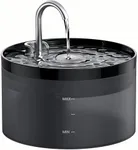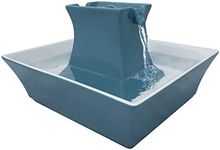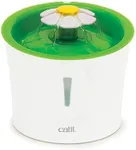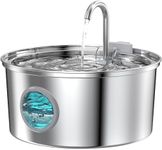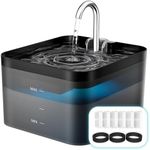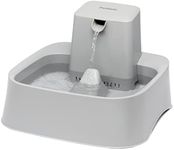Buying Guide for the Best Pet Fountains
Choosing the right pet fountain for your furry friend is essential to ensure they stay hydrated and healthy. Pet fountains provide a continuous flow of fresh water, which can be more appealing to pets than stagnant water in a bowl. When selecting a pet fountain, consider the size of your pet, their drinking habits, and the maintenance required. Here are some key specifications to help you make an informed decision.CapacityCapacity refers to the amount of water the fountain can hold. This is important because it determines how often you need to refill the fountain. For small pets or single-pet households, a smaller capacity (1-2 liters) may be sufficient. For larger pets or multiple-pet households, a larger capacity (3-5 liters or more) is recommended to ensure there is always enough water available. Consider your pet's drinking habits and how often you are able to refill the fountain when choosing the right capacity.
MaterialPet fountains are typically made from plastic, stainless steel, or ceramic. The material is important for durability, ease of cleaning, and your pet's health. Plastic fountains are lightweight and affordable but may harbor bacteria if not cleaned regularly. Stainless steel fountains are durable, resistant to bacteria, and easy to clean, making them a good choice for most pets. Ceramic fountains are also easy to clean and can be more aesthetically pleasing, but they are heavier and more fragile. Consider your pet's sensitivity to materials and your preference for maintenance when choosing the material.
Filtration SystemThe filtration system in a pet fountain helps keep the water clean and free of debris, hair, and other contaminants. This is important for your pet's health and to ensure they have access to fresh water. Look for fountains with multi-stage filtration systems that include activated carbon filters to remove odors and impurities, and foam filters to catch larger particles. Some fountains also have UV light sterilizers for added protection. Consider the quality of the filtration system and how often the filters need to be replaced when making your choice.
Noise LevelThe noise level of a pet fountain can affect both you and your pet's comfort. A quieter fountain is generally more pleasant to have in your home and less likely to scare or disturb your pet. Look for fountains with quiet or adjustable pumps that minimize noise. If your pet is particularly sensitive to noise, a fountain with a near-silent operation may be the best choice. Consider the placement of the fountain in your home and how noise levels might impact your household when selecting a fountain.
Ease of CleaningRegular cleaning is essential to maintain the hygiene of a pet fountain and ensure your pet has access to clean water. Fountains with simple designs and fewer parts are generally easier to clean. Look for fountains that are dishwasher safe or have easily removable components. Consider how often you are willing to clean the fountain and choose one that fits your maintenance routine. A fountain that is easy to disassemble and clean will save you time and ensure your pet always has fresh water.
Design and AestheticsWhile not as critical as other factors, the design and aesthetics of a pet fountain can still be important, especially if it will be placed in a visible area of your home. Some fountains have sleek, modern designs that can complement your home decor, while others are more functional in appearance. Consider the overall look of the fountain and how it fits with your home environment. Additionally, think about your pet's preferences – some pets may prefer a bubbling fountain, while others might like a free-falling stream.


